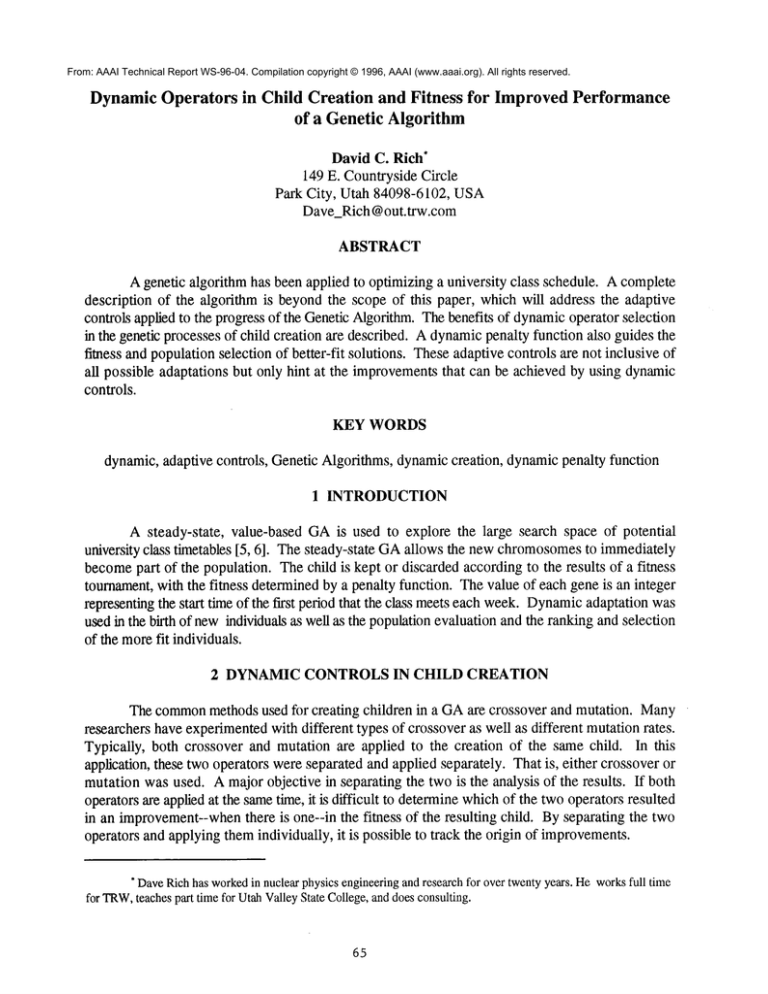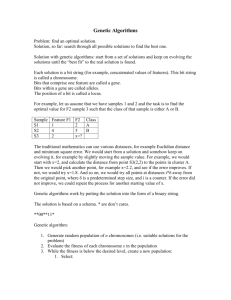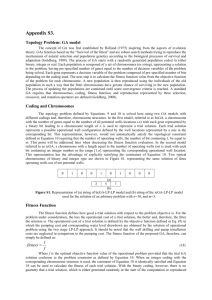
From: AAAI Technical Report WS-96-04. Compilation copyright © 1996, AAAI (www.aaai.org). All rights reserved.
Dynamic Operators in Child Creation and Fitness for Improved Performance
of a Genetic Algorithm
David C. Rich*
149 E. CountrysideCircle
Park City, Utah 84098-6102, USA
Dave_Rich@out.trw.com
ABSTRACT
A genetic algorithm has been applied to optimizing a university class schedule. A complete
description of the algorithm is beyondthe scope of this paper, which will address the adaptive
controls applied to the progress of the Genetic Algorithm.Thebenefits of dynamicoperator selection
in the genetic processes of child creation are described. Adynamicpenalty function also guides the
fitness and populationselection of better-fit solutions. Theseadaptivecontrols are not inclusive of
all possible adaptations but only hint at the improvementsthat can be achieved by using dynamic
controls.
KEY WORDS
dynamic,adaptive controls, Genetic Algorithms, dynamiccreation, dynamicpenalty function
1 INTRODUCTION
A steady-state, value-based GAis used to explore the large search space of potential
university class timetables [5, 6]. Thesteady-state GAallows the newchromosomes
to immediately
becomepart of the population. Thechild is kept or discarded accordingto the results of a fitness
tournament,with the fitness determinedby a penalty function. Thevalue of each gene is an integer
representing the start time of the first period that the class meetseach week.Dynamic
adaptationwas
used in the birth of newindividuals as well as the populationevaluationand the rankingand selection
of the morefit individuals.
2 DYNAMIC CONTROLS IN CHILD CREATION
The common
methodsused for creating children in a GAare crossover and mutation. Many
researchers have experimentedwith different types of crossover as well as different mutationrates.
Typically, both crossover and mutation are applied to the creation of the same child. In this
application, these twooperators were separated and applied separately. That is, either crossover or
mutationwas used. A major objective in separating the two is the analysis of the results, ff both
operatorsare applied at the sametime, it is difficult to determinewhichof the twooperatorsresulted
in an improvement--when
there is one--in the fitness of the resulting child. By separating the two
operators and applyingthemindividually, it is possible to track the origin of improvements.
"DaveRich has workedin nuclear physics engineering and research for over twenty years. He worksfull time
for TRW,
teaches part time for UtahValley State College, and does consulting.
65
Theprobability of selecting either crossoveror mutationis dynamic.Theinitial probabilities
for each one was 50%.Each operator selection rate changes during a run according to the success
of each operator in improvingthe fitness of the best chromosome
[2, 7]. As one operator provides
moreimprovementin the fitness, its selection probability increases at the expenseof the other
operator. As a result, one operator can dominatein the early generation, whichcrossover often does,
while the other operator, normally mutation, can domir/ate in the later population improvement.
Eachoperator is assigned a base probability that it cannot go below.This maintainsthe integrity of
alwayshavinga finite probability and not "losing" an operator. In this study, the base probability was
maintained at 20%.
Each operator has a success rate that keeps track of the fraction of the child chromosomes
created by it that remainafter each fitness competition.Eachoperator also has an integer credit that
is incrementedeach time that the operator generates a chromosome
with a fitness better than the
previousbest fitness. The"add-on"selection probability for mutationis calculated as the ratio of the
mutation"credit for best" to the summation
"credit for best" plus the ratio of the mutation"success
rate" to the summation
"success rate." Thetotal mutationselection probability is the sumof the base
selection probability plus the add-onselection probability:
sumCredit
= mutate.creditForBest + xover.creditForBest
= mutate.successRate + xover.sucessRate
sumSuccess
mutate.addProb = mutate.creditForBest / (1. + sumCredit)+ mutate.successRate/ (i.
sumSuccess)
mutate.opProb = mutate.baseProb + mutate.addProb
Thecrossoveroperator selection probability is calculated as one minusthe mutationoperator
selection probability:
xover.opProb = 1. - mutate.opProb
Thedynamicoperator selection probabilities were different in every run. In someruns, there
wouldbe large excursionsin the selection probabilities, while in others the selection probabilities
wouldbe close to 50%.Theywouldvary for each run as a different part of the schedulinglandscape
was explored. The dynamicselection rate, however, wouldprogress toward the operator with the
currently-best success rate. At the beginning of a run, the small numbersof successes for each
operator wouldresult in a few large changesbefore settling downto moregradual changes. Figure
1 displays a sampleof the changingoperator selection probabilities.
In this run, crossover dominatedthe selection probabilities for over two hundredchromosome
generations. Thedominancethen changeddramatically to favor mutation, whichalmost achieved the
maximum
selection probability of 80%.
66
The
later
dominance by mutation
is not always the case.
Figure 2 displays a
different
operator
selection graph. In the
run represented by this
graph,
crossover
dominated for a short
time, then mutation
took over. However,
mutation
only
dominated for a short
time before crossover
became
dominant,
again. As the run
continued,
both
crossover and mutation
selection probabilities
remained close to 50%.
0.8
o 0.7
o.6
O
0.5
0.4
_"’n
a-,’-/"-n..,.~
I
........................
Crossover
©~0.3
0.2
0
500
1000
1500
2000
Chromosomes Evaluated
Figure 1. Dynamic operator selection rates of mutation and
crossover during the generation of 2000chromosomes.Theselection
rates are adjusted accordingto the success of each operator to create
chromosomes
that improvethe population fitness.
The benefit of
dynamic
operator
selection is that the
selection rates can
0.8
change according to the
benefit to the population
0.7
progression--withoutthe
programmer
being
required to preprogram "~ 0.6 ["
, , Ix]
Crossover
or have prior knowledge .-.
of where these changes
should occur. And the
changes should occur at
Mutationi11
different times in the
~’w’
0"4"[i
operation, dependingon
" "j ..............
the domain that is
0.3
randomly selected for
searching. Because this
randomdomainselection
0
1000
2000
3000
4000
cannot be known in
Chromoson~es
Evaluated
advance,it is impossible
for the programmer to Figure 2. In this run, crossover dominated,then mutationtook
over, andthen crossover dominated, again. The operator selection
hardwire
the best
operator selection rates probabilities of both operators remainedclose to 50%.
67
for every potential landscape. Theimportant concept is that whateveroperators are selected, the
populationprogressionwill be enhancedby creating a dynamicselection process for the operator set.
This will allow the population to explore any area of the search landscape with prime operator
selection. Whensmall changesneed to be made,mutation can be emphasized,with a potential to try
large changes through crossover to jumpto a newpart of the landscape. Whenlarge changes are
needed, crossover can be emphasized.
3 DYNAMIC PENALTY FUNCTION
Thefitness of a chromosome
is calculated, in this study, using a penalty function. Apenalty
function allows the opportunityto gain informationfi’om data points that are valid for the GAbut not
for the problem.Instead of discarding genes that do not satisfy the physical constraints, they are
assessed a cost that causes the GAto movetoward moreacceptable results. This study addresses
both hard constraints and soft constraints. Hardconstraints are those constraints that can never be
violated in an acceptable schedule. Instead of disallowingthese data points during the processing,
these points are assessed a high cost. All hard constraints havethe samehigh cost, since a schedule
is unacceptableif any hard constraint is violated. Thehigh cost does not require an immediaterepair
of an unacceptablesolution but causes evolutionarypressure to movethe solution awayfromthe hard
constraints.
Soft constraints are those things that wouldbe nice to have (or not have) but their lack (or
existence) does not makea solution unacceptable. Soft constraints are restrictions that can be
allowed but are not preferred. Theseare assigned a muchlower cost than hard constraints, so that
the hard constraints can take precedence over the soft constraints during evolutionary search
procedures. Thecosts of the soft constraints can also be varied according to the relative value of
each constraint.
Thehard constraint costs are addedto the soft constraint costs to calculate the chromosome
fitness. Thefitness of the chromosome
is the inverseof the cost, whichresults in a value (fitness) for
each chromosome
that is in direct proportionto its value as a solution:
fitness = 1. / (1. + cost)
Thefitnesses of all chromosomes
in the populationare summed,
and a fitness ratio is assigned
to each chromosome.The fitness ratio is the chromosome
fitness divided by the summationof all
fitnesses, which identifies the value of each chromosome
relative to the other chromosomes.The
summation
of all fitness ratios is 1.
As the population of schedules evolves toward better and better schedules (chromosomes),
there will comea point wherethe schedulesare all equally good, or almost so. This point of almostequal fitness values is called convergence.Beasley[ 1] defines convergenceas, "... progression
toward increasing uniformity." In this project, whenthe average chromosome
fitness is within 95%
of the best-fit chromosome,
the population is said to have converged. After convergence,there is
very little improvementthat can evolve through crossover, since the chromosomes
are all almost
alike. Figure 1 implies that crossover is only effective for a few hundredchromosome
generations.
68
Since the operator selection rate is based on the success of each operator, the programcould be left
to continue to exploit mutationat an increasing rate. However,greater benefits can be achievedby
having a break in the proceduresafter convergence.
Whenthe population converges, all but the best-fit chromosome
are reinitialized to random
values within the legal gene range. Reinitializing a convergedpopulation provides for greater
diversity and improvesthe search process[3]. Thebest fit chromosome
is not reinitialized but is kept,
whichis called elitism. Elitism provides someassurancethat vital informationalready discoveredis
not lost throughthe reinitialization process. After reinitialization, the search continueswith the new
chromosomes
blending their genes with those from the best chromosome
previously discovered. This
break in the search process not only expandsthe domainsearched, but also allows for an operational
point where the penalty function can be madedynamic.
Constraint violation costs are madedynamicat the point of population reinitialization. The
scheduler begins with each constraint associated with a basic cost and a basic cost increment. Each
time the populationconvergesand is reinitialized, the best-yet chromosome
will (probably)have some
constraints unresolved.Thecost associated with each constraint violated by the best-yet chromosome
is incrementedby the associated cost increment.Theincreasing constraint costs put pressure on the
schedulerto increase the priority in resolvingthose constraints. Thegreater the cost of an individual
constraint, the greater is the pressure for that constraint to be resolved in the next evaluation. The
slowlyincreasing costs on violated constraints create increasing pressure on the schedulerto find the
lowest-energy, most stable solution.
With the total costs dynamic, the important factor is the relative cost increment. Those
constraints with the larger incrementsreceive greater pressure morerapidly and will be resolved more
quickly. As violated constraint costs are increased, those constraints will also be resolved until the
best possible scheduleis discovered. In the real world, the physical resources (rooms)rarely match
exactly with the required resources. Typically, the physical resources are greater than the minimum
required, and there maybe multiple timetable configurations that have a minimum-energy,
or almostminimum-energy,
class schedule.
Constraints that are difficult to resolve can generate very large costs through multiple
convergencecycles. Sometimes,the cost of a constraint can be increased significantly but then
becomedormantand insignificant whenthe constraint is satisfied. If the constraints wouldstay
satisfied, the large dormantcosts wouldbe irrelevant. However,as other constraints are satisfied,
somepreviously-satisfied constraints maybecomeviolated again due to the highly interrelated, or
epistatic, environment.Theconstraints forced into renewedviolation whensomeother constraint is
resolved, are immediatelyassessed the large dormantcost previously built up.
It is possible to avoid someof these down-the-roadsurprises by starting over. This program
is designed to accept a seed chromosomeas a memberof the initial population. Therefore, the
scheduling process can be run for a specified numberof chromosome
generations and then stopped.
Thebest chromosome
is then entered as a seed to a newrun begunwith all costs initialized to the
basic costs. As a result, the scheduler begins workingwith a best-yet chromosomebut at the
beginningof the dynamiccost cycle.
69
Dynamiccosts makeit difficult to comparethe best chromosome
in one cycle with the best
chromosome
in another cycle after someconstraint costs haveincreased. To overcomethis difficulty,
a "normoliTedcost" of the best-yet chromosome
is calculated. Thenormalizedcosts used are the cost
increments that have been entered relative to the importance of each constraint type. These
increments do not change. Thesummationof cost increments of all violated constraints therefore
provides a goodcomparative (normalized) measureof each chromosome’s
value throughout the many
cost-increasing convergencecycles.
Thenormalizedcosts can also increase as well as decrease. Whenone constraint is increased
in priority with the increasing penalty costs, it maydislodgeother less-penalizing constraints. This
can actually result in an increase in the normalized cost even whenthe total cost decreases. A
solution to this problemhas not yet been designed, except to continue with the evolution.
18000
1200
Average Costs
15000
1100
"x
Best Chromosome Cost
12000
I000
.......................
9000
.................
900
6000
..............
800
3000
..............
700
Normalized Best Cost
0
600
0
2000
4000
6000
Chromosomes Evaluated
8000
I0000
Figure 3. Cost data showingthe increasing costs using a dynamicpenalty function and the
normalized cost of the besl-fit chromosome.This run was extended to 10,000 chromosome
evaluations to allow the dynamiccosts moreopportunity to force improvementsin the solution.
The best schedule found still had a cost of 620, with manyhard constraints violated. The
acceptable solution had to be foundusing the dynamicpenalty function in conjunctionwith other
controls.
Figure 3 showsthe costs of a samplerun using a dynamicpenalty function. Notethat at about
4000evaluations, the normalizedcost of the best chromosome
beganto increase. However,later in
the run, the normalizedcost wasforced back downlower than it had been before the increase.
7O
4 SUMMARY
This study has shownthat dynamiccontrols applied to Genetic Algorithms helps the GA
search the potential landscapemoreefficiently from emphasizinglarge changesto emphasizingsmall
changes. Theyallow the programto modifythe search proceduresto the best advantageof the local
position in the search space, thereby improvingthe speed of the search. Themethodsapplied herein
are only examples. Recognizingthe potential for improvedperformance, continued research will
undoubtedlydiscover moreand better dynamiccontrols to enhance evolutionary performance.
REFERENCES
Beasley, D, Bull, D.R., and Martin, R.R. An Overviewof Genetic Algorithms: Part 1,
Fundamentals. In University Computing. 15, 2 (1993), 58-69.
lo
2.
.
.
.
.
.
Davis, L. Handbookof Genetic Algorithms. Van Nostrand Reinhold, NewYork, 1991.
Karr, C.L. Air-Injected HydrocycloneOptimization via Genetic Algorithm. In Handbook
of Genetic Algorithms, by L. Davis, 222-236. Van Nostrand Reinhold, NewYork, 1991.
Khuri, S., B~ick, T., and Heitkotter, J. An Evolutionary Approachto Combinatorial
Optimization Problems. In Proceedings of the ComputerScience Conference, 1994. March
8-10,1994. ACMPress.
Rich, D.C., AutomatedScheduling Using Genetic Algorithms, 2nd Annual Utah Workshop
On: Applications of Intelligent and Adaptive Systems, The University of Utah Cognitive
Science Industrial AdvisoryBoard and The Joint Services Software TechnologyConference
’94, April, 1994.
Rich, D.C., A Smart Genetic Algorithm for University Timetabling, 1st International
Conference on the Practice and Theory of Automated Timetabling (ICPTAT), Napier
University, Edinburgh, Scotland, UK,August, 1995.
Tate, D.M. and Smith, A.E. DynamicPenalty Methods for Highly Constrained Genetic
Optimization. Submitted to ORSAJournal on Computing, (Aug. 1993).
71










